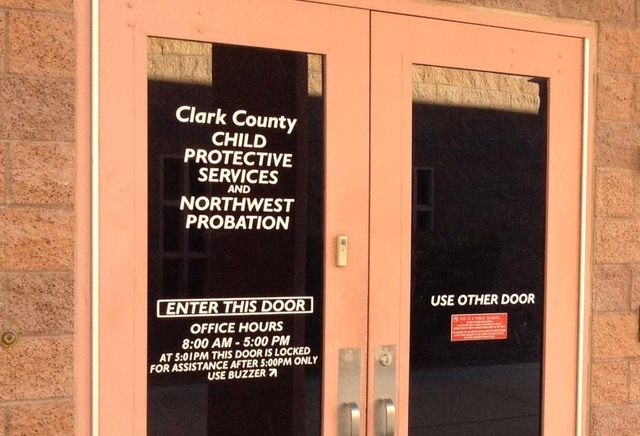Union leaders: Clark County child welfare caseloads still high
Large caseloads were among the safety concerns that led Clark County Department of Family Services’ employees and leaders with the Service Employees International Union to present a petition to Clark County commissioners in August.
Four months later, union leaders say caseloads in Clark County’s child welfare system are still high, especially in Child Protective Services.
County officials said they are managing caseloads well but look forward to getting more caseworkers.
“There has been no impact —reduction — in the amount of new cases assigned to individual (Child Protective Services), in-home and permanency workers,” union leaders said in a statement.
After the petition was presented, county officials acknowledged that caseloads were high and they said they planned to tackle Child Protective Services caseloads first.
Clark County assistant manager Jeff Wells at the time said there was a group of about 32 to 35 Family Services employees going through a child welfare training academy.
Those employees had been hired to fill vacancies in the department and the majority were going to be assigned to Child Protective Services investigations, he said at the time.
However, only 22 employees enrolled in the academy that started in August and only 19 of them graduated recently, Clark County spokesman Erik Pappa said.
Recent graduates have received limited caseloads with close oversight until they become proficient in case management, Pappa said.
“We are managing caseloads well, but look forward to receiving more caseworkers from future academies,” Pappa said.
Family Services generally sees a spike in the number of Child Protective Services’ cases each September and October, he said. In September and October of this year, it received an average of 967 new cases per month.
In the three months before that, it averaged 747 cases per month, Pappa said.
“We saw a 29 percent increase in (Child Protective Services) cases,” he said. “But we anticipate that over the next few months, the average caseload numbers will drop back down to the level of the mid-700s.”
Union leaders said they are in agreement with management that Child Protective Services caseloads are “too high” and the program is “understaffed.”
In July, Clark County commissioners approved 47 positions for Family Services. As of earlier this month, all but eight of those positions had been filled, Pappa said. The agency also got 49 additional positions in July 2013.
The next academy will start Jan. 12 and it will have 35 people, Pappa said. In an effort to lower caseloads in Family Services, the agency conducted three academies in 2014 and it will do so again in 2015. That will increase the number of new hires who are able to go through the academy.
“These expanded academies are having to fill more openings, however,” Pappa said. “Some 53 people left (Family Services) in the last six months – higher-than-usual attrition.”
Additionally, some new positions are being filled through internal promotions. While good for the employees, it has an adverse effect because it increases the caseload in the units of the promoted employees until their positions can be backfilled, Pappa said.
The plan to address this concern is to request additional positions for Family Services in March 2015, union leaders said. But they say that’s what they were told in 2012 and in 2013, noting not much impact has been seen.
In July, union leaders say they were advised of new Child Protective Services units and an academy that would help fill vacancies and add positions to the field. However, that didn’t occur.
“The last academy did not result in an addition of staff who were responsible for caseloads of children, who are reported to be unsafe,” union leaders said.
Pappa said all employees, regardless of program area, support children and families and help reduce caseloads.
“We constantly assign staff to areas where a demand must be met and shift resources to address any spikes that may arise,” he said.
As of Oct. 12, Child Protective Services’ caseload ratio was 1 to 11 cases, according to Family Services. The caseload ratio for permanency workers, who oversee children in foster care, was 1 to 13 cases, or 25 children on average per worker.
The in-home caseload ratio was 1 to 5 cases, or 16 children on average per worker, according to Family Services.
“We continue to be concerned that we are not receiving the resources we need to adequately meet the needs of the community as it relates to safety,” union leaders said.
And there is no academy that could replace the education and experience needed for positions in child welfare, union leaders said.
“However, continuous changes are made to the curriculum in good faith efforts,” they said.
Chrystal Main, spokeswoman with Nevada’s Division of Child and Family Services, said changes were made to the academy in March to include elements of a new safety model and to revise the flow of the course to follow the steps a worker takes in each case.
Employees in Washoe County also go through the same academy, she said. The academy is the introduction to important elements of casework, but it’s not expected nor intended to be the only training to prepare workers for the field.
“The academy is the first set of trainings that are offered by the state that all caseworkers participate in at the beginning of employment,” Main said. “However, there are many other trainings that are offered at the county and state level beyond what the academy provides specific to various child welfare topic areas.”
Contact Yesenia Amaro at yamaro@reviewjournal.com or 702-383-0440. Find her on Twitter: @YeseniaAmaro

















